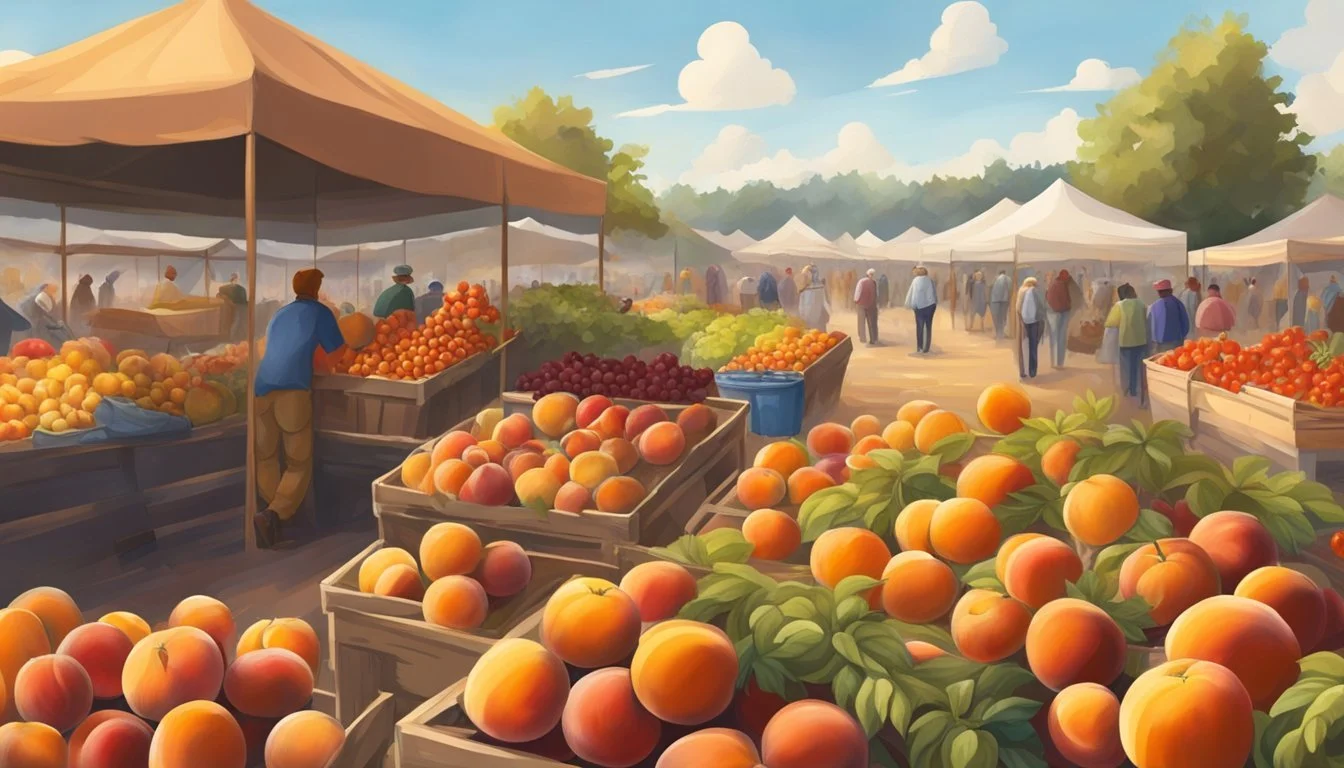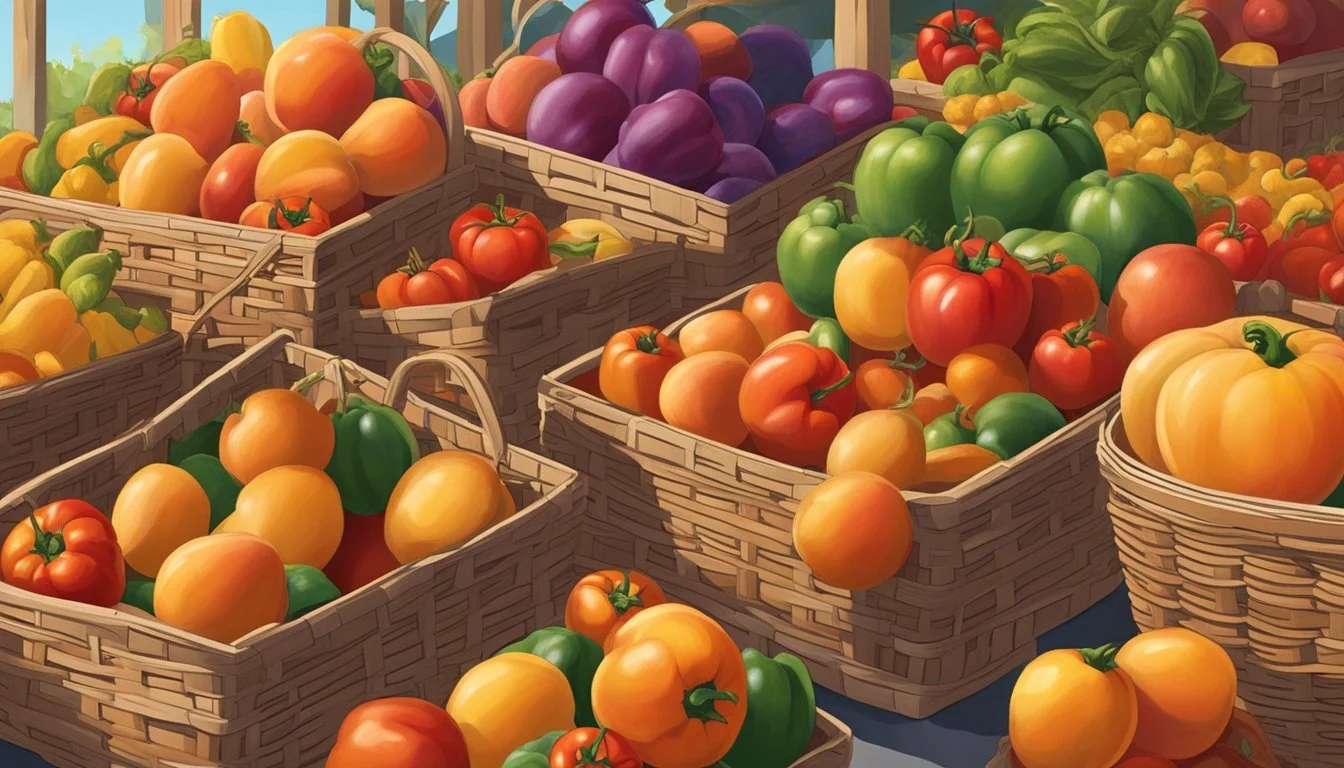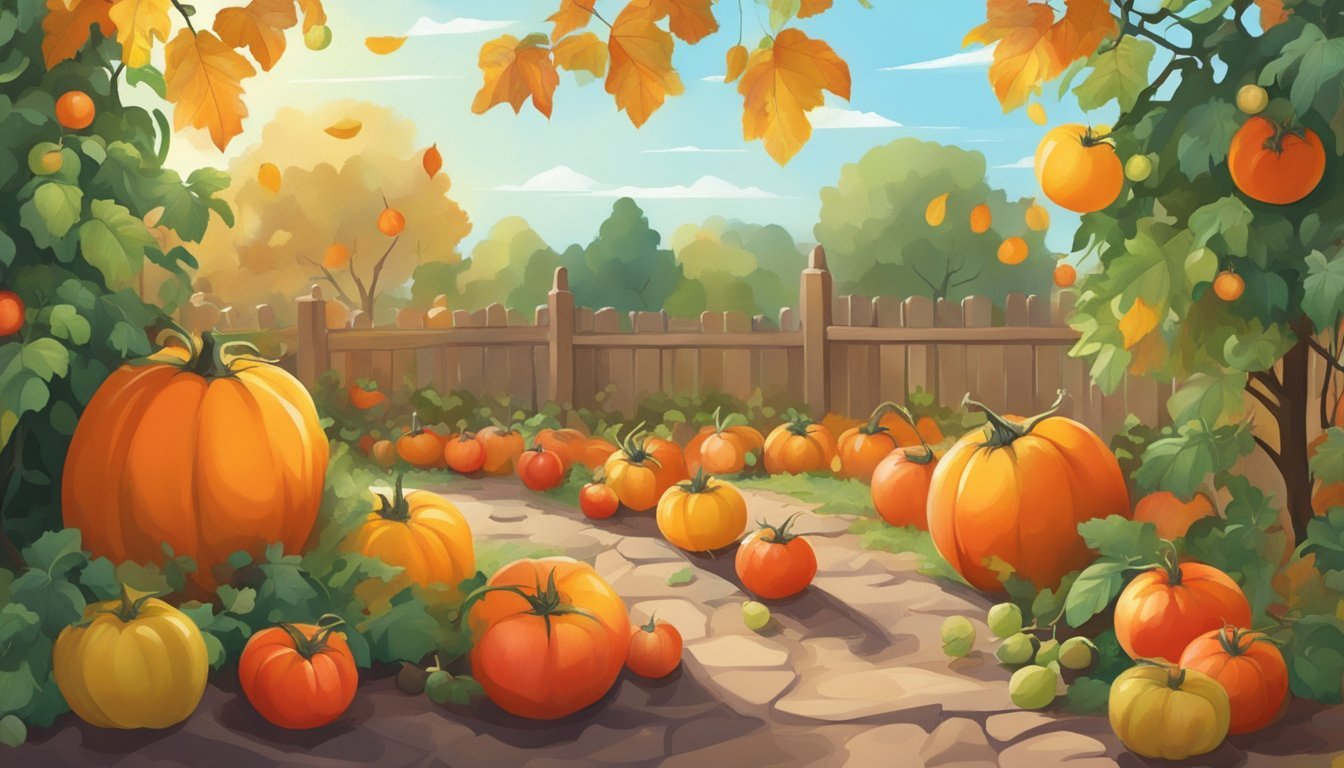Utah Seasonal Fruit & Vegetables in September
Your Fresh Produce Guide
This Article is Part of our Utah Seasonal Fruit & Veg Calendar
Utah offers a rich tapestry of agricultural bounty, especially as the year wanes into the cooler days of September. This transitional month ushers in a diverse harvest, where the last whispers of summer's sweetness overlap with the robust flavors of autumn's arrival. Farmers and gardeners across the state reap the benefits of the growing season, providing a fresh and local array of fruits and vegetables that define the regional cuisine.
September in Utah is particularly known for its fruitful harvests, with a variety of fresh produce reaching its peak. Orchard fruits such as peaches continue to thrive early in the month, while apples begin to take center stage. The state's apple varieties become a highlight at local markets, featuring both eating and cooking types, each with its own distinctive flavor and texture. Concurrently, a selection of vegetables is in abundance; crops like tomatoes, carrots (how long do carrots last?), and zucchini are commonly harvested, and greens such as spinach and lettuce thrive in the cooling weather, giving consumers access to fresh salads and sides.
As summer's heat ebbs, growers also turn their attention to planting cool-season crops. Lettuce, with its cold-hardy nature, is an ideal candidate for fall planting in Utah's climate. It demonstrates the greater cycle of agronomy within the state, showcasing a perpetuation of growth and harvest that ensures Utah residents can enjoy locally-grown produce nearly year-round. The changing seasons are embraced wholeheartedly, evidenced by the careful timing of planting and harvesting cycles that take advantage of September's unique weather patterns.
Understanding Utah's Growing Seasons
In Utah, the growing seasons are influenced by altitude, microclimates, and irrigation practices. Knowledge of these elements helps gardeners maximize their yields and maintain sustainable practices.
Spring Planting and Early Harvests
Spring in Utah starts the growing season, with hardiness zones determining the optimal time to plant seeds. Expect to see early harvests of peas, greens, and radishes as they thrive in the mild temperatures.
Summer Abundance in Utah Gardens
Summer in Utah brings an abundance of tomatoes, zucchini, cucumbers, peppers, beans, and berries. The warm temperatures create ideal conditions for these plants, leading to bountiful summer squash and garden overflow.
Preparing for Fall Harvest
As summer fades, fall planting begins. Gardeners in Utah plant carrots, Brussels sprouts (how long do brussels sprouts last?), kale, pumpkins, and winter squash, anticipating a harvest before frost sets in.
Winter Preparation and Planning
During winter, the garden beds often lay dormant, but it's a crucial time for planning and preparing seeds for the next season, based on the hardiness zone and expected temperatures.
The Microclimates of Utah
Utah's microclimates significantly affect plant growth. Local gardeners learn to interpret these variations to optimize their gardening choices throughout the growing season.
Optimal Planting Timelines
Utah's planting timelines are dictated by diverse climatic conditions. Gardeners use regional data to determine the most advantageous times to plant various species.
High Altitude Gardening Challenges
High altitude areas face unique challenges, including cooler temperatures and shorter growing seasons. Such conditions require careful selection and timing of plant species.
Utah Garden Pests and Diseases
Pests such as Japanese beetles, along with various plant diseases, can impact gardens in Utah. Timely identification and treatment are crucial to maintaining plant health.
Water Conservation and Drought Tactics
Water conservation and drought management are essential in Utah's arid climate. Gardeners implement efficient irrigation systems and drought-resistant plants to maintain their gardens.
Organic Gardening Practices
Adopting organic gardening practices helps manage pests and improves soil quality. Utah gardeners often opt for natural pest control methods and organic fertilizers.
Utah's Seasonal Produce Guide
As the autumn leaves begin to change in Utah, September brings a bountiful harvest of fruits and vegetables. This month offers a range of produce that is not only rich in flavor but also in nutritional value and versatility for culinary uses.
Fall Fruits and Vegetables Overview
In September, Utah's fields and orchards are abundant with a variety of fruits such as blackberries (how long do blackberries last?) and varieties of peaches including Red Haven and Angelus. Vegetables like broccoli (how long does broccoli last?), carrots, and cauliflower (how long does cauliflower last?) also reach their peak. These fresh picks are a testament to the state's rich agricultural offerings during the fall season.
Nutritional Benefits of Seasonal Eating
Eating seasonally ensures that produce consumed is at its optimal nutritional value. For instance, carrots, which are in season, provide a high dose of vitamin A and antioxidants when they are fresh. Similarly, blackberries contain vital nutrients such as vitamin C and fiber, making them a healthy addition to any diet.
Harvesting Guidelines for September Produce
Harvesting in September must be timely to ensure the peak quality of produce. Fruits like peaches should be picked when they are firm but yield slightly to touch, signaling ripeness. Vegetables such as broccoli are best harvested before the flower heads fully bloom to maintain both texture and taste.
Storing and Preserving Fresh Produce
To extend the enjoyment of September's harvest, proper storage is crucial. Cool, dry places are ideal for storing root vegetables like carrots, while fruits such as peaches should be kept at room temperature until ripe and then refrigerated. Preserving methods such as canning and freezing can also maintain the quality of the produce.
Seasonal Recipes and Cooking Tips
Utah's September produce can be transformed in the kitchen. A sweet and tart peach cobbler utilizes the fresh flavor of local peaches, whilst a hearty broccoli soup makes the most of the freshness of garden produce. Using these raw ingredients in recipes enhances both taste and nutritional benefit.
Local Farmers Markets and Community Supported Agriculture
Local farmers markets and CSA (Community Supported Agriculture) programs are prime sources for September's fruit and vegetable bounty. These venues support local farmers and provide communities with organic and fresh options. They also give consumers a chance to engage directly with the source of their food.
Home Gardening Vs. Commercial Farming
While commercial farming supplies a significant amount of produce, home gardening in Utah has its unique advantages, such as the ability to grow organic fruits and vegetables without commercial pesticides. It also offers a rewarding experience that connects individuals with the natural cycle of growth and harvest.
Utah's Key Seasonal Fruits
September ushers in a bountiful harvest season in Utah, where the fruit offerings are as diverse as they are flavorful. From succulent stone fruits to a variety of berries and tree fruits, Utah provides an impressive selection for fruit enthusiasts.
Stone Fruits Galore in September
In September, stone fruits reach their peak in Utah. The markets brim with peaches, plums, and apricots, each offering a unique blend of sweet and tart flavors. Among the peach varieties, Suncrest and O'Henry are particularly sought after for their juicy sweetness. Plums like the aptly named September Yummy are equally prized for their rich taste and texture.
Berry Varieties and Their Seasons
Berries in Utah are nearing the end of their season, but September still offers a range of options. Look for late-harvest blackberries and raspberries, cherished for their balance of sweetness and slight acidity. Strawberry varieties taper off, but those available continue to delight with their bright, sun-ripened taste.
Popular Apple and Pear Varieties
As summer transitions into autumn, apple and pear varieties begin to flourish. This is the time for apples like the Honeycrisp and Gala, which are perfect for both fresh eating and baking. Pears such as Bartlett and D'Anjou also make their way into the scene, offering a soft, buttery texture and a mellow sweetness ideal for both desserts and savory pairings.
Exotic and Uncommon Utah Fruits
While not as commonly found, Utah does produce some unique and exotic fruits that come into season in September. Varieties of melons can still be found, including specialty types that are lesser-known but boast an exceptional flavor profile. Additionally, certain grape variations developed for the region's climate may be available, presenting an opportunity for local connoisseurs to explore more uncommon tastes.
Crucial Vegetables of Utah in September
September in Utah showcases a rich harvest of vegetables. This period of transition from summer to fall brings a unique set of crops ready for picking, each with their own soil and climate requirements.
Root Vegetables and Their Harvest Conditions
Root vegetables thrive in the cooler start of fall. Carrots, turnips, beets, and radishes are key players, with rutabagas joining the lineup. These vegetables demand well-drained soil and do best with full to partial sunlight. They can typically withstand a light frost, making them ideal for the dropping temperatures of September.
Carrots and beets: Sow until midsummer for a late September harvest.
Turnips and radishes: Can be planted later for a quick mature cycle.
Leafy Greens and Salad Staples
September is prime for lettuce, with its various types including crisp romaine and tender butterhead. Spinach, kale, collard greens (how long do collard greens last?), and chard add diversity to the harvest basket. These greens prefer cooler temperatures and can continue to grow even under a light snow cover. Quick growth ensures a steady supply.
Lettuce: Flourishes in cooler weather, perfect for late sowings.
Kale and collard greens: Known for heat tolerance and flavor improvement after a frost.
Gourd and Squash Varieties
The gourd family makes a grand appearance with both pumpkins and squash varieties. Winter squash including butternut and acorn peak, while summer squash and zucchini wrap up early in the month. They require warmer soil to start but can be harvested into cooler weather.
Pumpkins: Maturity is signaled by hardening of the rind.
Winter Squash: Harvest before the first heavy frost for optimal storage.
Nightshades and Warm Season Produce
Nightshades like tomatoes, peppers, and eggplant are reaching the end of their cycle. The remaining heat of September aids in ripening the last of these warm-season fruits. Potatoes, also part of the nightshade family, can be dug up before the first frost for storage.
Tomatoes and peppers: Pick before the first frost when colors brighten.
Potatoes: Watch for foliage die-back as a harvesting cue.
Caring for Your September Garden
As September arrives, gardeners in Utah must focus on pest control, efficient watering, soil fertility, and strategic pruning and crop rotation to maintain a healthy and productive garden.
Preventative Pest Control Measures
To safeguard plants from pests, which can be particularly active in the early fall, gardeners should regularly inspect their garden for signs of infestation. Recommended actions include:
Physical barriers: Use netting or floating row covers to protect vulnerable crops.
Natural predators: Encourage beneficial insects like ladybugs that prey on common pests.
Irrigation and Watering Best Practices
September can still be dry, and appropriate irrigation is crucial for plant health. Gardeners should:
Morning watering: Irrigate early to reduce evaporation and allow foliage to dry, preventing fungal diseases.
Drip systems: Employ drip irrigation or soaker hoses for deep watering that conserves water and targets roots.
Soil Health and Fertility Maintenance
Healthy soil is the foundation of a successful garden. To maintain fertility, gardeners should:
Composting: Add well-decomposed compost to provide nutrients.
Mulching: Mulch around plants to retain moisture and suppress weeds, while also adding organic matter as it decomposes.
Pruning and Crop Rotation Strategies
Pruning and crop rotation are vital for plant health and disease prevention in the garden. Effective strategies include:
Pruning: Remove dead or diseased foliage to improve air circulation.
Crop rotation: Rotate crops annually to disrupt disease and pest cycles and maintain soil health.
Exploring Agricultural Zones in Utah
Utah's diverse climate presents various agricultural zones, significantly impacting what and when gardeners can plant. The state's garden enthusiasts primarily engage in Zones 5 and 6, while also making use of local microclimates to extend their growing capabilities.
Gardening in Zone 5
Zone 5 in Utah, including areas around Ogden and Provo, experience average minimum temperatures between -20 to -10 degrees Fahrenheit. Gardeners in this zone can plant:
Fruits: Apples, pears, and cherries are well-suited for this zone. These fruit trees should be planted in early spring as soon as the ground is workable.
Vegetables: Hardy vegetables like kale, broccoli, and Brussels sprouts thrive in the cool season and should be sown in mid to late summer for a fall harvest.
Cultivating in Zone 6
In Zone 6, encompassing cities such as West Jordan, the climate is slightly warmer with minimum temperatures ranging from -10 to 0 degrees Fahrenheit. The gardening calendar here allows for a broader variety of fruits and vegetables:
Fruits: Stone fruits including peaches and apricots fare well in Zone 6, with the ideal planting period in late winter or early spring.
Vegetables: Garden staples such as tomatoes, peppers, and cucumbers are planted after the last frost date and harvested through late summer and early fall.
Adapting to Local Microclimates
Microclimates within these zones can alter the gardening landscape, allowing for the cultivation of less hardy species or extending the growing season. Utah's gardens benefit from understanding their local climate nuances:
Use of strategic planting locations, such as south-facing slopes or sheltered areas, can protect from frost and capitalize on warmth.
Raised beds and row covers can modify soil temperature and protect plants from climate extremes.
The specific alignment of climate zone, plant selection, and understanding of one's own garden microclimate is key for a successful harvest in Utah.
Conclusion
September marks a bountiful period in Utah's harvest calendar. Gardeners and local farmers bring a variety of fresh produce to the table and to farmers markets, celebrating the peak of late summer yields and the onset of autumn's bounty. Vegetables such as broccoli and cauliflower continue to thrive, while root vegetables like carrots and celeriac come into season. This is an excellent time for consumers to take advantage of the fresh produce at their local farmers markets.
Fruits are less prominently featured, but markets may still offer late-summer varieties that have enjoyed the warm weather. Residents and visitors alike are encouraged to support local agriculture by purchasing seasonal produce which, in turn, provides freshness and supports sustainability.
Here is a brief list of seasonal produce to look for in Utah during September:
Vegetables:
Broccoli
Cauliflower
Carrots
Celery
Farmers and gardeners are preparing for the end of the growing season, making the most of the September harvest before the first frosts. This is an ideal time for consumers to engage with the local food scene, learn about sustainable practices, and enjoy the wealth of produce that September in Utah has to offer.








